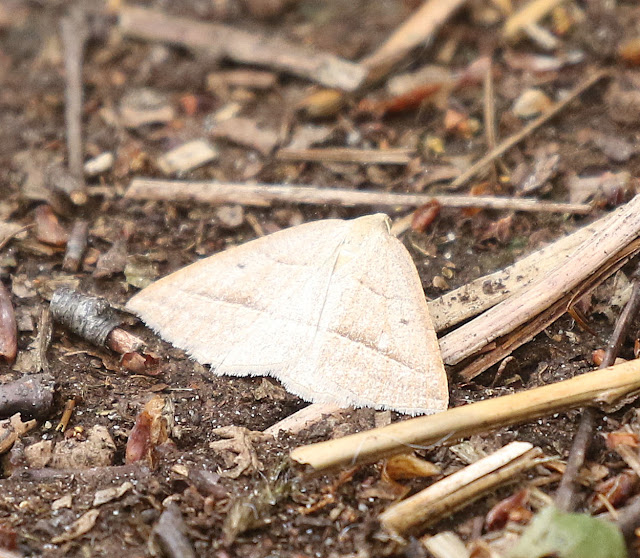A Hobby at Thorne Moors
This week was half-term, so we got the chance to visit some lowland heathland habitats, which are maybe too far and involve too much walking to manage during just a couple of hours. Despite the time of year the weather was quite disappointing. Instead of sunny skies and lots of dragonflies we had overcast weather and plenty of mosquitoes!
On Wednesday we met at Thorne Moors and walked the extraordinarily long distance to the reserve. Before we started we had screaming Swifts over our heads, little did we know they were to prove the theme of the day. On the way we heard a distant Yellowhammer, a Chiffchaff, but mostly resident birds. Once we arrived the dense vegetation meant that the mosquitoes really started about their business, but they abated again once the trees became less close. A silent Jay flew across our path at this point, a bird we weren't to encounter again that morning. As the vista began to expand we saw a Yellowhammer a few Reed Buntings, and Deborah spotted a Lapwing. I also spotted the heads of three Red Deer, which eventually ran off in a westerly direction. We could also hear more than one Cuckoo "singing"from various directions.
At the T-junction we turned left and soon ran into a bug-hunter. He kindly pointed out a Scarce Vapourer Moth caterpillar, which none of us had ever seen before. Our walk was punctuated by the odd Reed Warbler song, a bubbling female Cuckoo, while one of the males got louder. The reeds in the shattered area were covered in small damselflies. We reached Fison's Road, but this time there was no Grasshopper Warbler, and we had gone a long way before we eventually came across a Sedge Warbler. Several times female Cuckoo flew across the road ahead of us, and the male Cuckoos became even louder. Meanwhile, Swifts were whizzing over our heads the whole time. We saw at least 4 Marsh Harriers flying in various directions - most of them appeared to be females. The lowering clouds meant that we weren't destined to see a single Hobby. We had various sights of ducks flying over including Gadwall, Shoveler, a Tufted Duck and of course several unmentionables.
Scarce Vapourer
We had lunch in the picnic area, but this was where we had to change direction, as great areas of the moor had been closed. This was the muddiest section, but was enlivened by a male Stonechat. We were able to turn again and made our way to the viewing platform. This year the Marsh Cinquefoil was only just showing above the water-filled ditch. We did see some later poking through the duckboards.
Male Stonechat - the first bright bird ever on this blog
Marsh Cinquefoil
On the way back it began to rain, which rather spoiled the return journey.
Yellow Wagtail
Preening
Ditto
On Thursday we visited Hatfield Moor for the first time in over half-a-decade. The journey didn't take as long as I remembered, so my nephew and I avoided the mess caused by the construction of the new office building, and we had a look in the hide. The best bird to see here was a Yellow Wagtail among all the debris, but all the while we were serenaded by the lovely song of a Woodlark. Also here were: Lapwing, Oystercatcher, Tufted Duck, Pied Wagtail and later Little Grebes were here too. Of course by the time everyone else arrived the Yellow Wagtail was never to show itself so well again.
One advantage to Hatfield Moor is that you are among the wildlife straight away, whilst at Thorne you have to walk a mike through a post-industrial landscape first.
Freshwater Mussel
Skimmer
Almost as soon as we started we came across a series of freshwater mussels, which implies that Boston Lake consists of good quality water. We soon discovered that there were many more large dragonflies on the wing than there were the previous day, but it was also a lot warmer - in a very muggy sort of way.
Skimmer
Tiger Beetle
Dragonfly Exuvia
Southern Marsh Orchid
Ragged Robin
Marsh Cinquefoil
As we reached the moor area we saw several moths and a few Tiger beetles. We did hear ands see birds, but very few of these were close enough to be photographed. One of the most mind-boggling sights came when we were in the area most bedevilled by fierce and biting mosquitoes. We came across a path through woodland, and were rather shocked to see only a short way down the path - a pair of elderly nut-brown naturists. Goodness knows how they keep off the biting insects. To preserve their modesty, despite not having any modesty themselves, I restrained myself from taking any photos of them. We carried on trying to avoid more insect bites. As we neared the car park we did see another Yellowhammer and a few farmland birds. A singing Curlew was more of a surprise, and Chris spotted an Oystercatcher in a recently-tilled field. There were plenty of interesting flora to look, and when we almost back at the cars we came across a small but active group of Common Blue butterflies. It would be nice to go again on a sunny, but breezy day, when the malicious insects would probably be less intrusive.
























No comments:
Post a Comment